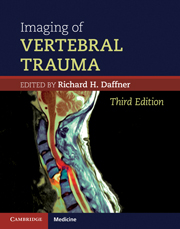Book contents
- Frontmatter
- Contents
- List of contributors
- Preface to the Third Edition
- Preface to the Second Edition
- Preface to the First Edition
- Acknowledgments
- 1 Overview of vertebral injuries
- 2 Anatomic considerations
- 3 Biomechanical considerations
- 4 Imaging of vertebral trauma I: indications and controversies
- 5 Imaging of vertebral trauma II: radiography, computed tomography, and myelography
- 6 Imaging of vertebral trauma III: magnetic resonance imaging
- 7 Mechanisms of injury and their “fingerprints”
- 8 Radiologic “footprints” of vertebral injury: the ABCS
- 9 Vertebral injuries in children
- 10 Vertebral stability and instability
- 11 Normal variants and pseudofractures
- Index
11 - Normal variants and pseudofractures
Published online by Cambridge University Press: 21 April 2011
- Frontmatter
- Contents
- List of contributors
- Preface to the Third Edition
- Preface to the Second Edition
- Preface to the First Edition
- Acknowledgments
- 1 Overview of vertebral injuries
- 2 Anatomic considerations
- 3 Biomechanical considerations
- 4 Imaging of vertebral trauma I: indications and controversies
- 5 Imaging of vertebral trauma II: radiography, computed tomography, and myelography
- 6 Imaging of vertebral trauma III: magnetic resonance imaging
- 7 Mechanisms of injury and their “fingerprints”
- 8 Radiologic “footprints” of vertebral injury: the ABCS
- 9 Vertebral injuries in children
- 10 Vertebral stability and instability
- 11 Normal variants and pseudofractures
- Index
Summary
The preceding chapters discussed using imaging to diagnose fractures and dislocations of the vertebral column. This chapter explores entities that are often confused with fractures and that may be misdiagnosed as fractures. It is just as important for the radiologist and referring physician to be familiar with normal variants and pseudofractures that simulate fractures as it is for them to be able to recognize the fractures themselves [1,2].
This chapter explores five groups of findings that may be misinterpreted as fractures:
normal variants and anomalies
Mach bands
subjective contours
overlapping extraneous materials
old fractures.
The list of entities that may mimic fractures is lengthy, so discussion is limited to the salient features of the most common variants and pseudofractures.
A few general comments regarding pseudofractures are in order. The majority of acute fractures have sharply defined, irregular margins that will fit together like pieces of a jigsaw puzzle (Fig. 11.1). This principle is valid even when fragments are displaced. In this situation, it is possible to mentally “move” the fragments together. Old, ununited fractures or accessory ossicles have smooth, rounded margins and do not have this “jigsaw puzzle effect” (Fig. 11.2). Some accessory ossicles begin life as acute fractures and later remodel when they fail to unite. The common limbus deformity of the lumbar spine is a good example of this (Fig. 11.3). Similarly, lucent lines caused by vessels have parallel sclerotic margins.
- Type
- Chapter
- Information
- Imaging of Vertebral Trauma , pp. 192 - 220Publisher: Cambridge University PressPrint publication year: 2011



